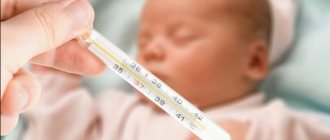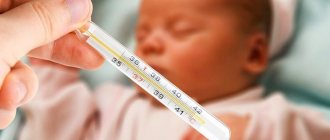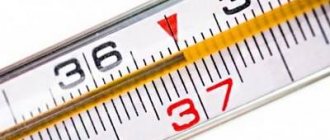- May 18, 2019
- Potency
- Vladislav Bulkin
Often, mothers of boys in the maternity hospital notice all sorts of problems with the scrotum and testicles of their babies. For example, a child’s testicle is swollen or does not descend into the scrotum. Even a minimal deviation from the normal location of the testicles is a reason to contact a specialist so that he can identify the existing problems. But parents should not panic at all, make a diagnosis and carry out treatment on their own.
The scrotum is a skin and muscle pouch that performs a protective function. The testicles descend into the scrotum before the 35th week of pregnancy. This process is very important, because if the testicles do not descend in time, sperm will not be fully produced during adolescence, which in the future will affect the process of childbearing in a boy. Why is a child's testicle swollen? It's worth looking into this issue.
Causes of swelling in babies
The newborn may be more fussy and restless and may cry when bathing or changing a diaper. If a child has a swollen testicle, the reasons can be very diverse:
- A hydrocele is an elastic and soft formation, and either one or two testicles can swell without persistent redness. Upon palpation, you can feel that fluid is accumulating inside the testicle.
- Injury. The scrotum can be damaged during childbirth. This condition should not cause any particular concern - the swelling goes away after a few weeks.
- Inguinal or scrotal hernia. Testicular swelling may occur due to prolapse of organs located in the abdominal cavity. The baby develops the following symptoms: constipation occurs, swelling when palpated may disappear. The only way to solve this problem is to perform surgery.
- Testicular torsion. Initially, the organ turns red and compaction is observed in this place. This is a rather serious illness and, if not treated promptly, can cause atrophy of the genital organs. Also, in most cases, the child’s general condition worsens: he vomits, becomes restless, cries often, and the temperature may rise.
- The testicle may also become swollen as a result of certain cancers.
Testicles in newborn boys: one larger, drooping and other problems
Are you expecting the birth of your son or have you already become a happy mother of a tiny gentleman. Taking care of a newborn is not only a pleasant task, but also a great responsibility. What do parents of a boy need to know, what should they pay special attention to from the first days of his life?
Parents should take into account that the genitourinary system of children, in this case the testicles of newborn boys, is at risk. Carefully monitor the child’s development, promptly detecting possible urological problems and solving them in a timely manner. The slightest suspicion is a reason to take your son to a specialist.
Size differences and swelling are normal
In the first trimester of pregnancy, testicles (testicles) are formed. This process occurs in the abdominal cavity of the fetus. In babies born at full term, the testicles should descend into the scrotum. In premature babies, they are usually located in the inguinal canal and over time they independently occupy the desired position.
A slightly enlarged scrotum in a newborn boy is considered normal. Slight swelling and slight pigmentation of the skin of the scrotum are the result of a hormonal crisis, which is inevitably experienced by the baby’s body after leaving the mother’s womb.
The testicles of a newborn are elastic to the touch. The testicles are a paired male sex gland, but their sizes are slightly different: one (usually the right one) is larger than the other.
Absence of testicle in the scrotum
For various reasons, testicular descent is not always complete by the time of birth. And cases where a baby has one or both testicles that have not descended at the time of birth are quite common. The anomaly (cryptorchidism) is diagnosed in the maternity ward during the first examination.
It is worth noting that now many experts do not consider the absence of one or even two testicles in the scrotum of an infant to be a cause for concern.
In most cases, the problem resolves by the sixth week of life without intervention. But the process can take up to a year. Children need constant monitoring to prevent associated complications. You will need to consult a urologist, and, if necessary, an endocrinologist.
While swaddling the boy, the mother is able to control the presence of testicles in the scrotum herself by lightly palpating it on both sides.
There is also a phenomenon, false cryptorchidism. A baby's testicles are very mobile. In some babies, due to cold or muscle tension, they hide in the peritoneum or inguinal canal, but soon return to their proper place. False cryptorchidism disappears during adolescence.
There are cases when cryptorchidism requires surgical intervention. Depending on medical indications, surgery is prescribed within a period of six months to a year. Experts strongly recommend not to postpone it. At a later age, it usually gives only a cosmetic effect; the testicle will not be able to perform the functions of the sex gland.
Big testicles
Another situation is often observed: a baby boy is born with swollen testicles. Large testicles in a baby are not a cause for concern. This condition usually goes away quickly. And although postpartum swelling of the testicular membrane does not require treatment, it is better for the child to be under the supervision of a specialist. Enlarged glands may be symptoms of a disease such as dropsy.
Hydrocele of the testicles
Hydrocele of the testicles occurs quite often in newborns. A disease when fluid accumulates and is retained in the membranes of a baby’s testicles. The result is that the entire scrotum or one of its halves increases.
The sex of the baby is determined at the moment of conception in the womb of the mother. At the final stage of scrotal formation, a septum forms between the testicles and the abdominal cavity, preventing the penetration of fluid.
If even a small cavity remains between the peritoneum and the scrotum, it is gradually filled with serous fluid. In medicine, the disease is called hydrocele.
Pathology of the membrane can cause testicular hydrocele.
How to recognize a dangerous anomaly? The scrotum begins to enlarge due to a pear-shaped seal. Sometimes the swelling takes on an hourglass shape. A sign of water entering the seed canal.
The size of the dropsy varies from a small bump to a swelling the size of a ball. The structure of the skin of the scrotum does not change. It is elastic, mobile and clean, sometimes redness appears. Dropsy does not make urination difficult and does not cause pain.
The cause of the disease is not always a violation of the septum. It happens that the membrane is overgrown, but the scrotum still fills. Congenital hydrocele of the testicles develops due to a malfunction of the infant’s lymphatic system.
The shells of paired glands secrete a special liquid that reduces their friction.
The excess should be absorbed back, but in the first months of a baby’s life the lymphatic system often fails to cope with this task.
As a rule, this disease requires constant monitoring by a pediatric urologist. By one year the signs of dropsy usually disappear. If, nevertheless, the swelling does not go away and continues to increase, then after two years such children are operated on. There is also a possibility that a baby's testicular hydrocele can develop into a hernia.
Testicular hernia
Boys are at increased risk of developing a testicular hernia. A serious and dangerous phenomenon that threatens the life of the baby. Similar to torsion, a hernia can lead to testicular death. The disease negatively affects intestinal function.
https://www.youtube.com/watch?v=mRyUQa9OLds
A testicular hernia is a congenital defect. There is a unilateral testicular hernia. The right is at risk three times more often than the left. The only way to get rid of the problem is surgery. It is carried out even in the first days after birth.
It is easy to detect a hernia visually. It manifests itself in the form of a protrusion in the groin area and is clearly visible when a child screams, cries, or during physical activity. The hernia is felt when palpated. Mom should not neglect regular examination of her son during swaddling and bathing.
Testicular torsion
When your boy suddenly starts crying, do not rush to attribute the pain to ordinary colic. Check the reaction to touch in the groin area.
If the source of pain is there, doctors strongly advise promptly going to the hospital.
There may be a rather dangerous complication of cryptorchidism called testicular torsion, volvulus, or entrapment. With torsion, blue skin of the scrotum is often observed.
The bloat causes the boy very severe pain and can lead to very unpleasant consequences. Only a qualified doctor can help in this situation.
If help is not provided in a timely manner, then after a few hours the testicle can be damaged, and after about a day the changes will become irreversible.
Typically, testicular impingement occurs in infancy or between 10 and 14 years of age. Unfortunately, surgery cannot be avoided for such a problem.
Do not try to treat this disease yourself. Ointments and compresses will not help here. You will only miss time that can cause serious complications, for example, necrosis (death) of the testicle.
Atrophy
Torsion can also lead to testicular atrophy: a decrease in size and the gradual death of its functions. Atrophy can also develop after some infectious diseases.
Redness, rash and spots on the scrotum
Sometimes parents complain about their child's red testicles. In fact, this is redness of the skin of the scrotum. The cause of the trouble is often simple diaper rash. Irritation occurs in skin folds due to excessive moisture caused by increased sweating at high temperatures or poor hygiene.
The boy's genitals should be clean and dry. This will get rid of many inflammatory processes and dangerous diseases. Urologists are unanimous in their opinion: many men’s health problems begin in the first five years of life. One of the reasons is violation of hygiene rules. This is important for the parents of the little gentleman to remember.
If you are not sure that the redness is caused by diaper rash, it is better to consult your pediatrician or dermatologist: redness of the scrotum is a common symptom of the following diseases:
- Testicular torsion: redness of the testis, increase in size, increase in body temperature, vomiting.
- A hernia can cause redness of the testicles. The consequence and one of its symptoms is constipation.
- Injury. Redness or hematoma as a result of injury in infants is rare.
- Infection. In addition to redness, it is sometimes accompanied by a rash.
- Hydrocele. Red testicles may be one of the symptoms of dropsy.
It happens that a rash and spots on the scrotum indicate an allergic reaction to diapers or a food allergy. Skin dermatitis is also accompanied by the appearance of spots and rashes on the body, including the genital area.
Let's sum it up
The testicles of a newborn boy should be in the constant attention of his parents. Not only the health and proper development of the baby, but also its ability to lead a normal sex life and have children in the future depends on proper child care, hygiene and timely treatment of diseases of the genitourinary system.
If you punctually and regularly examine your baby, take into account the advice of doctors, and do not neglect hygiene, then the risk of male problems and inflammatory diseases will be minimal.
Expert recommendations
- Pathologies of the scrotum and testicles can be hereditary, but the course of pregnancy is also of great importance for the normal formation of the fetus. Colds, infectious or viral diseases of the expectant mother can cause problems in the development of the fetus, including delayed testicular descent and dropsy.
- Smoking, especially during pregnancy, is a direct path to the development of such pathologies. Therefore, the expectant mother must approach the period of waiting for the birth of her child very responsibly.
After birth, follow the instructions of your pediatrician and be sure to consult with specialists in case of the slightest deviation from the norm.
Source: https://LechimKrohu.ru/ginekologiya/yaichki-u-novorozhdennyx.html
Causes of swelling in 1-14 years old
In older age, the causes of the disease are determined by symptoms and type:
- Epididymitis or orchitis. With this disease, the testicles may become red, swollen and painful. Usually the condition develops after chickenpox, ARVI, mononucleosis or cured mumps. Undoubtedly, the inflammatory process in the epididymis and testis will cause great discomfort to the boy. Without proper treatment, the inflammation will spread to neighboring organs.
- Swelling of the testicle due to vasodilation. Swelling can develop due to mechanical impact (impact, fall) on the scrotum.
- Varicocele, in which the child constantly complains of pain.
- Spermatocele: The child does not experience any special symptoms, but discomfort usually occurs due to the increased amount of fluid in the testicles.
- A cyst can also cause testicular swelling.
- Dropsy.
- Testicular torsion.
- Inguinal hernia.
Where are sperm produced?
The formation of male reproductive cells - sperm - is a continuous process. This occurs in the seminiferous tubules. One epithelial cell of such tubules can produce up to 8 germ cells. In one minute, about 50 thousand germ cells are produced in the tubules.
In the epididymis, sperm mature and can swim in fluid. If their mobility is insufficient, this may indicate infertility.
Interestingly, for the normal functioning of these male gonads, a temperature of about 32ºC is required. If this indicator is higher or lower, then the intensity of spermatogenesis, that is, the formation of sperm, is much lower. Therefore, they should not overheat, otherwise it will negatively affect fertility.
Is it time to go to the doctor?
Undoubtedly, pathological swelling of the child’s testicles and genital appendages worries parents, who should immediately contact an experienced doctor. This is especially important if the following symptoms appear:
- Sharp stabbing pain in the groin.
- Temperature increase.
- Nausea and vomiting.
- Pathological location of the testicles, deformation of the organ, irregular outline of the scrotum.
- The swelling is accompanied by redness of the skin.
- Excessive enlargement of the testicles.
The most important thing is self-examination
Initially, you need to make sure that the testicles are actually different. To do this, stand in front of a mirror and carefully examine your testicles. It is best to do this immediately after visiting the bath or shower, as this will help the organ relax as much as possible.
The following indicators should be normal:
- the left testicle is lower than the right or vice versa, but this deviation is not immediately noticeable, which means it is not too pronounced. This situation is considered the norm, and accordingly, there is no reason to worry about this;
- the color of the scrotum must be the same in all places;
- when straining in the scrotum area, no unpleasant sensations appear, especially pain;
- when each testicle is squeezed individually, pain does not appear;
- When lifting the appendage to the groin area and its subsequent lowering, there should be no pain or other unpleasant sensations.
If the right testicle is larger than the left or vice versa, and this difference is very noticeable, most likely we are talking about some kind of pathology. This is especially true if, along with different sizes, there are symptoms such as uneven coloring of the skin, different temperatures, and pain. The sooner you find out what caused this phenomenon, the higher the chances that the problem can be eliminated without any risk to the man’s health.
Self-diagnosis
Parents should regularly inspect the baby's testicles and scrotum: it is necessary to feel the organs while bathing, since at this moment the water relaxes the muscles as much as possible, and the testicles descend into the scrotum.
You need to carefully feel the appendages, trying to roll them. Normally, they are elastic and soft, can be easily felt and move freely between the fingers. You also need to visually inspect the skin of the scrotum for the possible presence of protruding veins and redness of the skin.
If even mild swelling of the testicle is detected, it is necessary to lift it up and palpate the scrotum as carefully as possible. If one part of the scrotum is slightly lower than the other, this is normal. It is also important that there is no redness or excessive varicose veins on the genitals.
How is the organ structured?
The testicles are a paired human reproductive organ, located in the scrotum (if these glands are located in the retroperitoneal space, this indicates the development of cryptorchidism). The organs are oval in shape and have a dense consistency.
The testicles are separated by a septum and suspended on the spermatic cords. The upper end of the testicle tilts slightly forward, and the lateral surface slightly backward. The location norm is asymmetrical (that is, one is slightly lower than the other). Moreover, it is the left testicle that is located below. There is no scientific explanation for this particular location. It is quite possible that this protects them from injury while walking.
The size of the testicle is from 4 to 6 cm in length and 25-35 mm in width. The weight of the testicles is from 15 to 30 g. There is an upper, that is, outer, end of the testicle and a lower end (located inside), in addition, outer and inner surfaces, its edges - anterior and posterior.
The predominant part of the surface of the gonad is covered with peritoneum. Underneath it there are two membranes - the albuginea and the vaginal membrane. The tunica albuginea forms the mediastinum posteriorly. It protrudes into the thickness of the organ in the form of a spongy structure. From this mediastinum septa, consisting of connective tissue, extend. These partitions form lobules. The arrangement of such partitions is radial. The lobules are cone-shaped, and in each of them there are tubes, that is, seminiferous tubules. An interesting fact is that the length of each tubule can reach 1 m, and the diameter can be up to 0.25 mm. It is in them that the formation and maturation of sperm occurs.
All these tubules form a densely branched network. Efferent tubules emerge from it into the mediastinum and enter the epididymis. It has a vas deferens that connects to the duct. All this forms one vas deferens, which opens in the urethra.
The testicle is enclosed in the tunica vaginalis. And finally, its tissue is completely covered by the visceral membrane.
Examination by a doctor
The doctor diagnoses a swollen testicle in several successive stages. First, the tumor is illuminated with a special light to identify the retention of exudate, which may be the cause of this disease.
The doctor may also prescribe an ultrasound, which will help determine the volume of possible fluid in the testicle and reveal the exact nature of the tumor. If an inflammatory process is suspected, a small patient may be prescribed a urine and blood test, as well as a puncture of exudate.
Causes of testicular enlargement
If the testicle is lower than its “partner” and there are obvious signs of pathology, you will need to determine the nature and complexity of the problem present. Now medicine knows a sufficient number of provoking factors and diseases that lead to the occurrence of this pathology:
- injuries are one of the most common causes. Traumatic damage is typical mainly for soft tissues, while the egg itself remains intact. The problem leads to tissue swelling. As a rule, no treatment is required, since it will all go away on its own in a fairly short time. But severe injuries can lead to damage to the testicle itself, and this is fraught with such serious troubles as hemorrhage. This problem requires a solution with the help of a specialized specialist;
- Cancer is the most serious, unpleasant reason that one testicle is higher than the other. In this case, there is no need to talk - immediate treatment is required, probably surgical intervention too;
- Epididymitis is an inflammatory process of the epididymis that occurs in men. In this case, the reasons for this are promiscuity of sexual relations;
- inflammation of the testicle - occurs mainly due to non-compliance with personal hygiene rules, as well as prolonged wearing of uncomfortable, tight underwear.
Importance of treatment
Many parents may confuse a testicular tumor with dropsy, believing that this condition will go away on its own without contacting a doctor. But without proper treatment, the tumor can increase significantly. In children, swelling usually develops quite slowly, accompanied by testicular hydrocele.
It is worthwhile to carry out diagnostics at the slightest pathology. If a boy's testicle is swollen (the testicle has increased in size), the condition may have a malignant course. For example, testicular cancer begins to metastasize at the initial stage, quite quickly penetrating the lymphatic system of a fragile organism, affecting it.
Initially, the inguinal and nearby aortic lymph nodes may become inflamed. After this, other distant organs suffer. The swelling of the left and right testicles is practically no different. In this case, the diagnosis, symptoms and treatment are the same. The difference lies only in the final degree of damage, when one testicle is significantly larger than the other in size.
Testicular development in boys
In boys, paired gonads should descend at birth. If this does not happen, cryptorchidism develops. It can be one-sided or two-sided. The doctor advises parents to wait until 9 months, and if the boy’s testicles have not dropped before this time, undergo surgery. The most suitable time for such an operation is up to 1.5 years of age.
Parents should know what negatively affects the condition of their membranes. In turn, this leads to infertility. The father must teach his son to inspect the texts on his own.
The development of the gonads in boys can be divided into several stages:
- 1. Before the onset of puberty, the volume of the gonads, as a rule, is no more than 3 cm³. Such small testicles usually appear by the age of 10, after which their growth resumes.
- 2. Until the age of 12, the scrotum increases slightly in size, and the fatty tissue in it disappears. At the same time, the gonads increase slightly in size.
- 3. At the stage of activation of the gonads, their sharp increase in size occurs.
- 4. By the age of 14-15, the tissues are already beginning to produce full-fledged sperm. Moreover, the process of sperm maturation occurs continuously. The fact that this is happening is evidenced by the appearance of wet dreams - involuntary discharge of semen, usually at night.
- 5. Until the age of 17-18 years, the size of the gonads reaches adult levels. And if this does not happen, then there is still no reason to believe that sexual development is slowing down. In some men, the development of the gonads ends only by the age of 20 or even a little later.
Or maybe dropsy?
Dropsy in boys is a disease characterized by excessive accumulation of water between the membranes of the scrotum. This disease, according to statistics, affects about 7-9% of children. It is noteworthy that initially it is quite difficult to determine the development of this pathology, but after some time the scrotum along with the testicles may turn blue and red, and the child usually has difficulty urinating.
The main symptom of developing dropsy is that the boy’s testicle is swollen (the testicle has increased in size). The patient may also experience bluishness of the skin of the scrotum, which intensifies during palpation. Sometimes the tumor may even feel mobile. If hydrocele develops after a genital injury, the boy may complain of “bloating” and pain in the groin, problems with going to the toilet, chills, insomnia, increased fatigue and anxiety.
If the testicles are swollen in an infant, surgery is usually not required. It is enough just to follow the rules of hygiene and see a doctor. He may prescribe a testicular puncture to be able to remove excess fluid from it.
Usually, treatment of dropsy occurs in a child without any special complications in the process of healing of the process of the abdominal cavity and the physiological development of the baby. Let us remind you that surgical intervention for dropsy is not indicated!
If dropsy is reactive, it is necessary to cure the underlying disease. Infectious, acute and non-communicating type of hydrops without treatment can acquire an unfavorable prognosis, requiring hospital monitoring.
What to do if a newborn’s testicle has not descended: causes and treatment
At the birth of a boy, attention is paid to what kind of testicles babies should have.
When examining the baby, they monitor the condition of the organ and its position. Various pathologies associated with the small size of the genital organ, its atrophy, displacement of one or two testicles, and dropsy are identified. It happens that one testicle in a newborn does not descend into the scrotum. The neonatologist will immediately determine the pathology.
But the disease can develop later, so the mother should be attentive to her son.
A disease detected in time is treated faster and more successfully.
Description and qualification of the disease
Normal testicles in a newborn boy are:
- located in the scrotum;
- have sizes from six to eleven millimeters;
- the right one is slightly larger than the left one;
- elastic to the touch;
- slightly hyperemic.
There are various pathologies associated with the condition of the infant’s genital organs:
- Non-descending of one or two testicles is common and is called cryptorchidism. The problem disappears when the child reaches six months. If the pathological process is prolonged, then surgical intervention will be required.
- The situation when in newborns the testicle is not in the scrotum, but is hidden in the peritoneum or inguinal canal, is called false cryptorchidism. This condition is provoked by the baby’s muscle tension and being in a cold room.
- The reasons that a newborn has one testicle much larger than the other lie in the filling of the cavities with serous fluid. The danger of dropsy is its development into a hernia.
- A hernia in the groin can be felt visually. It can be discovered by a mother while bathing her son. Education causes anxiety for the child, and the hernia must be removed.
- When the scrotum is pinched, the skin turns blue.
- Untreated pathologies lead to organ atrophy and reduction in size. The disease develops after the baby has had infections.
- If redness of the testicles is detected in a baby, then the cause of the disease is non-compliance with hygiene rules. Diaper rash in the groin leads to irritation of the skin of the scrotum. But serious pathologies such as hernia, torsion, dropsy, and organ injury are accompanied by redness of the affected area. The appearance of a rash on the scrotum is a consequence of an allergic reaction.
The genital area of boys from birth is under the attention of parents and pediatricians. The condition of the scrotum and testes depends on proper care of the baby and the attention of the people around him.
Causes of hydrocele in newborns
Dropsy, or hydrocele, is diagnosed in every sixth newborn. By one year, the pathological condition returns to normal. After all, it is known what a testicle looks like in a newly born child. In a newborn boy, one egg appears larger than the other.
But the cause of hydrocele in the baby’s scrotum is considered to be the presence of:
- hormonal imbalances;
- infections suffered by a woman while bearing her son;
- pressure inside the abdominal cavity;
- underdevelopment of the testicular ligament;
- shortening of the spermatic cord;
- birth trauma.
Provokes the appearance of hydrocele complications after surgery.
If one of the testicles has descended in a newborn boy, then the pathology is associated with a lag in the growth of the child’s pelvis in relation to the genital ligaments. Cryptorchidism occurs more often in premature babies than in those born on time.
Characteristic signs and symptoms
Among the main symptoms of genital pathology is the disproportionate diameter of the testicles of newborns. Normally, the sizes of the right and left testicles differ, but not much. But with the disease, one or both testicles cannot be felt in the scrotum. The pathology can be cured by taking vitamin E drops.
If one of the baby’s testicles does not descend even after treatment, then surgery is prescribed.
Symptoms of the disease in a newborn include:
- an increase in the size of one or two testicles with bluish fluid visible through the skin;
- the appearance of irritation and rash on the skin;
- swelling in the affected area;
- inflammation of the flesh with retention of urine.
Even if the baby’s testicles have just turned red, they should immediately contact a pediatrician.
Methods and general rules for treating pathology
It is necessary to treat pathologies of the genital organs in any case. It is important to convey information to parents about an undescended testicle and explain what cryptorchidism is. After all, any deviations in the structure of the genital organs are fraught with future disruption of male spermatogenesis. And this is loneliness, the inability to start a family, mental problems.
Endocrinologists and andrologists treat pathology together with a pediatrician. Therapy begins when the child is nine months old. Treatment includes:
- injections of the hormonal drug Chorionic Gonadotropin;
- rubbing the product into the scrotum area, prepared from baby cream and calendula ointment;
- massage of the scrotum, abdominal cavity;
- taking the infusion of coltsfoot and sweet clover three tablespoons five times a day.
But if the symptoms of cryptorchidism do not disappear, then surgery will help restore the condition of the reproductive system. When redness of a baby's testicles occurs due to irritation, ointments with an antiallergic effect are also included in the treatment. Bathing your baby with chamomile and coltsfoot infusions added to the water will also save you from pathology.
Surgical intervention
Surgical reduction of the testicle into the scrotum is used in children aged one and a half to three years. The operation is carried out successfully, preserving the organ’s ability to reproduce. In adolescence, it is more difficult to restore normal spermatogenesis in a boy with pathology.
In pediatric urology, the operation is not complex. The surgeon separates the egg from the surrounding tissue. Thanks to the sufficient length of the spermatic cord, it returns the “fugitive” to its place in the scrotum. The danger is a disruption of the blood supply to the groin area. It is important to preserve it so that the organ does not undergo atrophy.
If the baby has one testicle larger than the other, then the operation is not performed for babies. The physiological process will normalize the baby’s genitals.
Caring for your child after surgery
The boy who has undergone surgery is monitored as much as possible for a week. In mild cases - two days. The success of the intervention is determined by examination after twenty days. During the rehabilitation period, the child is required to:
- observed the rules of hygiene of the genital organ;
- wore a jockstrap;
- did not engage in vigorous physical activity;
- followed the rules of nutrition.
There are no other methods of treating pathologies in the groin area. Therefore, parents and children need to prepare for surgical intervention.
Survival of newborns with one of the eggs is possible, but without the hope of being a full-fledged member of society.
Possible complications
Undescended testicles, or cryptorchidism, are common. And delaying the elimination of pathology, taking only hormonal drugs will lead to unpleasant consequences:
- Textile wandering is characterized by infertility due to a disruption in the process of sperm formation.
- As a consequence of a protracted pathological process in a newborn, degeneration of the testes is observed.
- Often, as a result of the disease, tissue necrosis and a hernia in the groin develop.
According to some doctors, the prognosis of the disease can be positive if a donor testis is transplanted or an implant is inserted.
Even a slight redness on the baby’s testicles should not go unnoticed by parents and pediatricians. It can lead to serious complications.
Source: https://grudnichky.ru/lechenie/ne-opustilos-yaichko.html
Surgery
If indications for non-conservative treatment are identified (the boy’s testicle is swollen, there is severe pain in the testicle, the presence of an inguinal hernia, an infectious lesion), the doctor may still prescribe surgery. This procedure is not dangerous and complicated: the operation lasts about half an hour, but proper preparation should be done in advance.
Preoperative preparation includes therapy for acute respiratory viral infections and infectious diseases. This will make it possible to prevent the development of possible complications and infection or even pneumonia after surgery.
Before the operation, the doctor prescribes an ultrasound scan for the child, the necessary laboratory tests, as well as other effective studies. Since the operation to eliminate dropsy is performed under anesthesia, it is advisable not to allow the child to drink or eat 7 hours before the operation.
Surgical treatment for the fact that the boy has a swollen testicle (water accumulates in the testicle, etc.) is performed in a hospital, and after a few hours the child and his parents are sent home, having been explained how to properly apply dressings and when to come for a postoperative medical examination.
Often, the occurrence of dropsy in a child may indicate the following concomitant diseases: lipospadia, cryptorchidism, prematurity, underweight, cystic fibrosis, testicular torsion, infectious lesions, peritoneal dialysis, liver diseases with the release of ascites, false hermaphroditism, hypospadias, complicated heredity, etc.
What kind of organ is this and why is it needed?
Initially, it must be said that testicles are very important for men. After all, it is in them that the production of sperm occurs, which gives the guy the opportunity to become a father. But they also produce a hormone such as testosterone. And he is responsible for the presence of masculine qualities in a representative of the stronger sex.
Common testicular measurements are as follows.
- Between 4 and 8 centimeters in length.
- From 2 to 4 centimeters wide.
It should be noted that this is an average and there is no medical criterion to establish that someone who is above or below this average is suffering from a physical problem.
Causes of testicular inflammation
In the previous section we explained the normal size of testicles, but more important than comparison with others, what you should keep in mind is comparison with yourself if your testicles swell or change over time. One testicle larger than the other in a child. is normal as it has not yet developed its reproductive organs and if one had a larger testicle than another it should not be a cause for concern.
The testicles are a paired human reproductive organ, located in the scrotum (if these glands are located in the retroperitoneal space, this indicates the development of cryptorchidism). The organs are oval in shape and have a dense consistency.
The testicles are separated by a septum and suspended on the spermatic cords. The upper end of the testicle tilts slightly forward, and the lateral surface slightly backward. The location norm is asymmetrical (that is, one is slightly lower than the other). Moreover, it is the left testicle that is located below. There is no scientific explanation for this particular location. It is quite possible that this protects them from injury while walking.
The size of the testicle is from 4 to 6 cm in length and 25-35 mm in width. The weight of the testicles is from 15 to 30 g. There is an upper, that is, outer, end of the testicle and a lower end (located inside), in addition, outer and inner surfaces, its edges - anterior and posterior.
The predominant part of the surface of the gonad is covered with peritoneum. Underneath it there are two membranes - the albuginea and the vaginal membrane. The tunica albuginea forms the mediastinum posteriorly. It protrudes into the thickness of the organ in the form of a spongy structure. From this mediastinum septa, consisting of connective tissue, extend.
These partitions form lobules. The arrangement of such partitions is radial. The lobules are cone-shaped, and in each of them there are tubes, that is, seminiferous tubules. An interesting fact is that the length of each tubule can reach 1 m, and the diameter can be up to 0.25 mm. It is in them that the formation and maturation of sperm occurs.
All these tubules form a densely branched network. Efferent tubules emerge from it into the mediastinum and enter the epididymis. It has a vas deferens that connects to the duct. All this forms one vas deferens, which opens in the urethra.
The testicle is enclosed in the tunica vaginalis. And finally, its tissue is completely covered by the visceral membrane.
Reviews from experts
Doctors say parents should closely monitor their children. After all, even incorrectly worn panties that pinch the organ will lead to such a pathology. Therefore, in order to prevent illness, it is necessary to carefully choose clothes, monitor the hygiene and play of children.
Being mothers of boys, as you can see, is quite difficult. When the first symptoms appear (if a child has a swollen testicle and pain), the main thing is to examine the child yourself as quickly as possible, and then seek advice from an experienced specialist. In any case, the disease can be cured when seeking medical help.
Testicular development in boys
In boys, paired gonads should descend at birth. If this does not happen, cryptorchidism develops. It can be one-sided or two-sided. The doctor advises parents to wait until 9 months, and if the boy’s testicles have not dropped before this time, undergo surgery. The most suitable time for such an operation is up to 1.5 years of age.
Parents should know what negatively affects the condition of their membranes. In turn, this leads to infertility. The father must teach his son to inspect the texts on his own.
Change in children
Immediately after birth, the obstetrician, and then the mother herself, must study the structure of the genital organs of the newborn. Already at this age, appendages can have different sizes. You need to immediately consult a doctor, and not try to eliminate the detected problem with the help of various compresses and lotions, which is what many irresponsible parents do.
In a boy, an imbalance in the size of the testicles can be caused by the following factors:
- dropsy. This is due to problems with the lymphatic system, as a result of which excess fluid accumulates in the scrotum. Dropsy is very easy to identify - it is a dense, but at the same time elastic formation, localized in one appendage. The sizes can be both large and small - it all depends on the neglect;
- cryptorchidism and/or orchitis are classic congenital pathologies that are not as rare as we would like.
- Varicocele – this disease traditionally manifests itself at an early age. Previously, few people dared to put their child under the knife because the operation was complicated. Now there are more practical methods for eliminating pathology, and therefore leaving everything as is is not recommended;
- injuries – children and adolescents are susceptible to various traumatic injuries, including to the genitals. Due to injury, the right testicle may be higher than the left and vice versa. Parents should carefully examine the site of the bruise and assess the extent of the damage. If you have doubts that the consequences of the injury will disappear on their own, it is better to consult a doctor.











